The positive rate with the common sexually transmitted agents and some relevant factors of the patients with urethral/vaginal discharge syndrome
Objective: to investigate the positive rate with 11 sexually transmitted agents and some relevant
factors of the patients with urethral/ vaginal discharge syndrome examined at National Hospital of
Dermatology and Venereology from August 2018 to July 2019.
Subjects and method: 120 patients with clinically urethral/vaginal discharge syndrome were
tested to find 11 sexually transmitted agents using molecular hybridization test.
Results: The ratio of male/female was 2.7/1. The most common age of suffering from disease was
20-29 years old. The positive rate with at least one agent was 33.3%. Chlamydia trachomatis (CT) was the
most common agent, accounting for 13.3%. Other agents had the positive rates as follows Neissseria
gonorrhoeae (NG) 6.7%; Mycoplasma gentalium (MG) 9.2%; Ureaplasma parvum/Ureaplasma urealyticum
(UU/UP) 7.5%; Mycoplasma hominis (MH) 1.7%; Herpes simplex virus type 1/2 (HSV 1/2) 1.7%; Human
papillomavirus type 6/11 (HPV 6/11) 8.3%; there were no cases positive for Trichomonas vaginalis (TV).
The coinfection rate among the cases with positive results was 13/40 (32.5%). In which, the coinfection
rates of MG-UU/UP 36.4%; CT-NG 25%; CT-UU/ UP 18.7%; MG-CT 18.2%. The positive rate with the agents
was higher in the group of patients with cloudy discharge and subjective symptom.
Conclusion: The urethral and vaginal discharge syndrome was often common in the age with strong
sexual activity. The prevalence of sexually transmitted agents in this group of patients was relatively
high, in which a lot of cases were co-infected more than one agent. There was a relation between the
positive rate with the agents and the discharge properties and subjective symptom of patients.
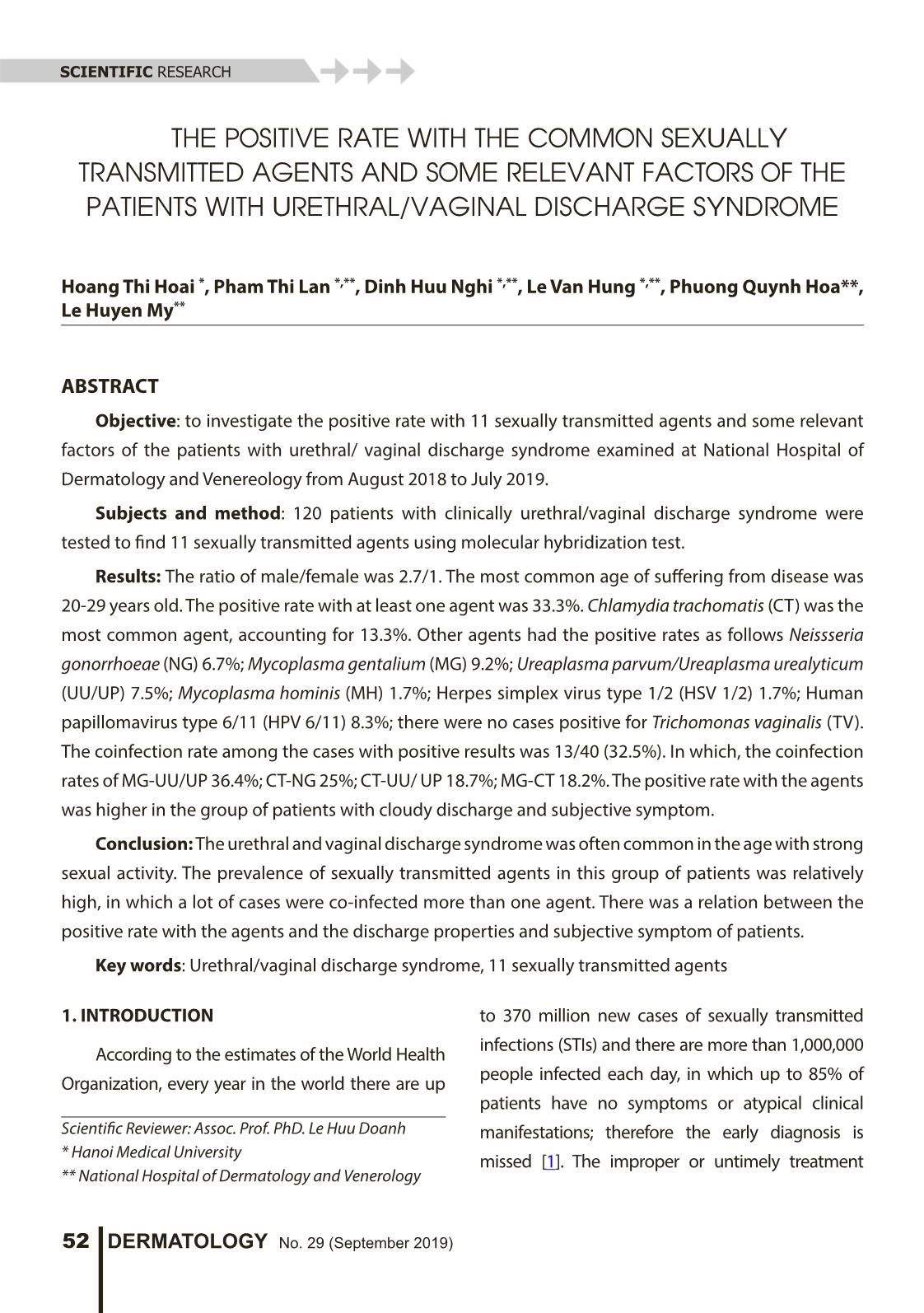
Trang 1
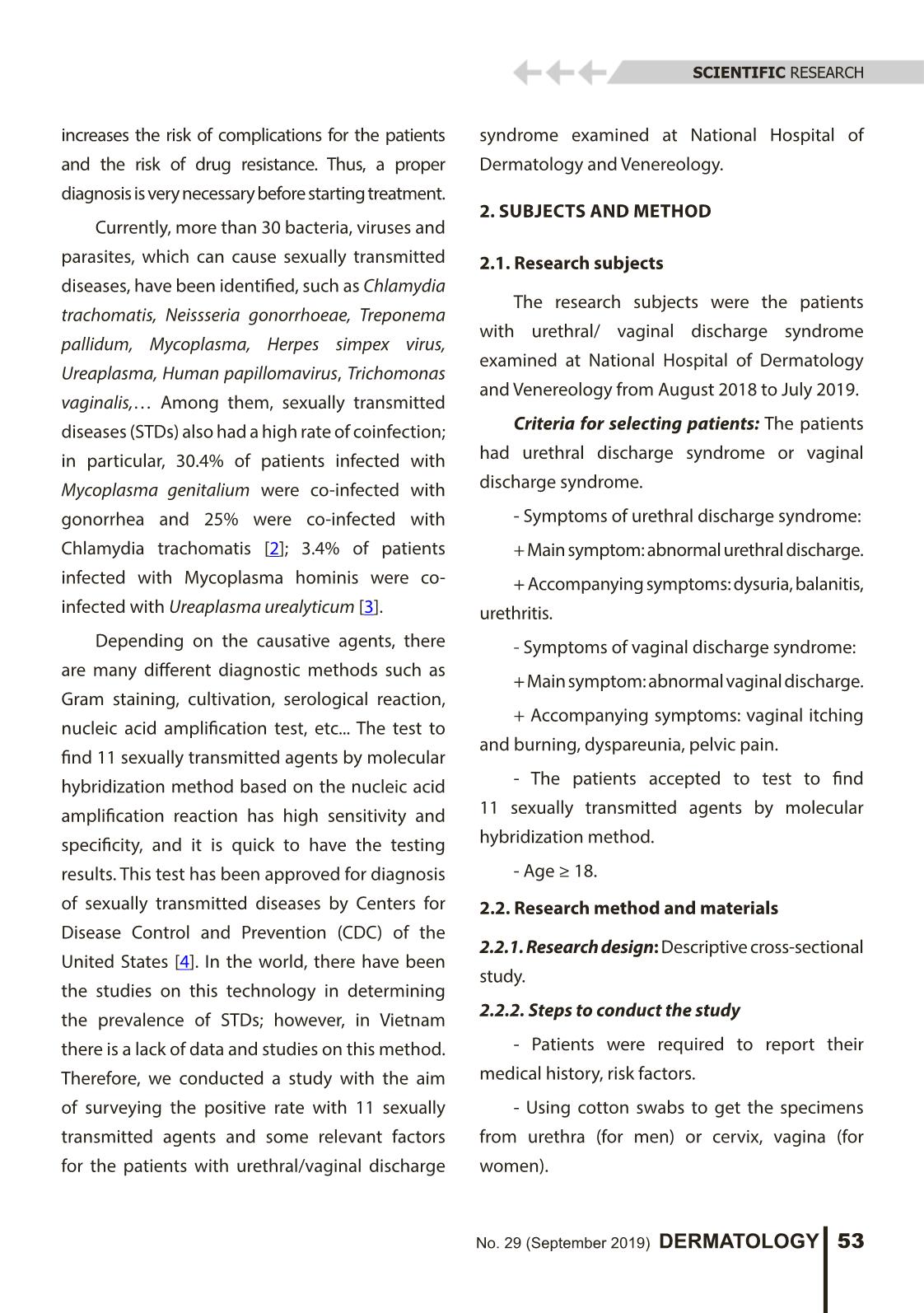
Trang 2
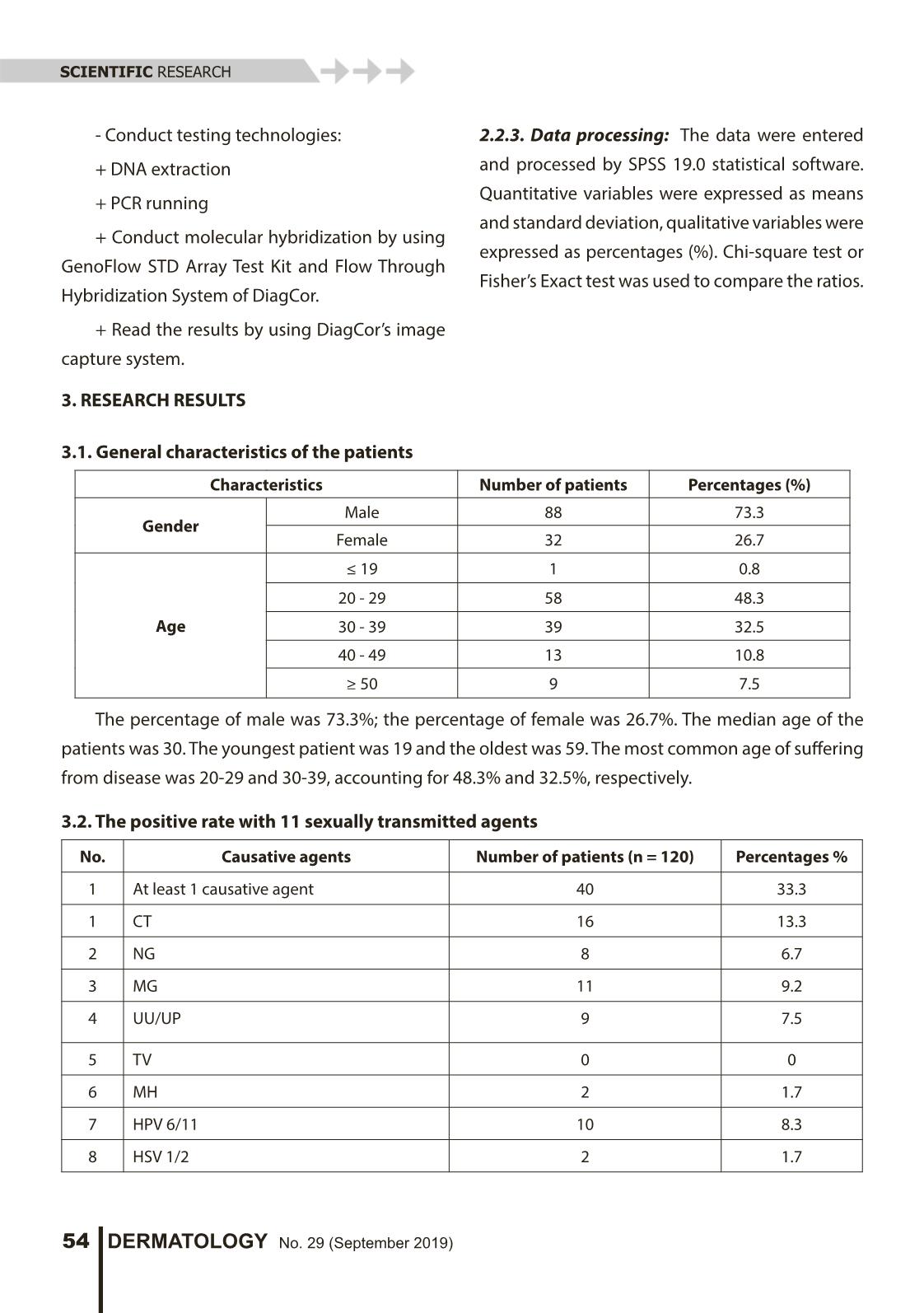
Trang 3
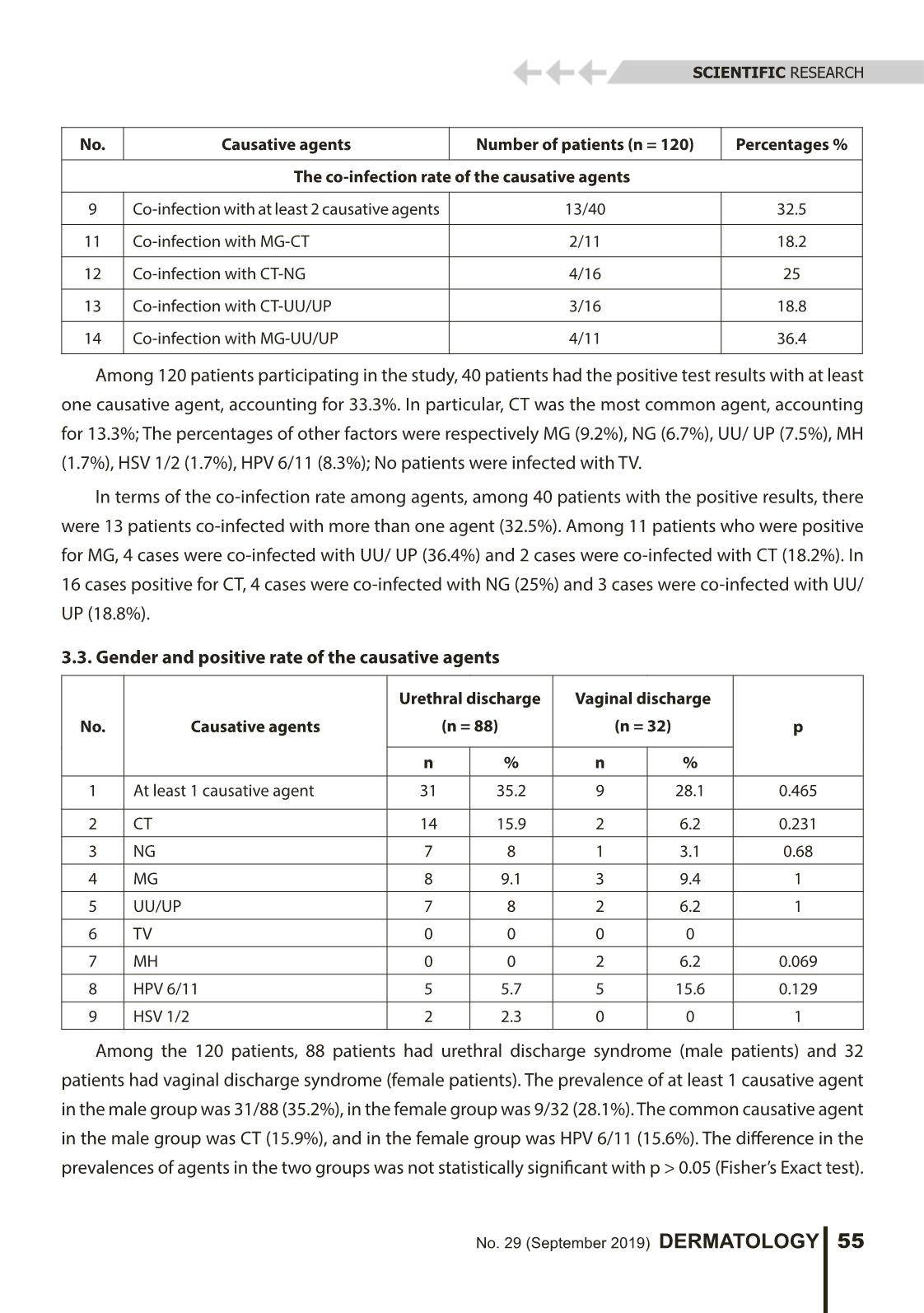
Trang 4
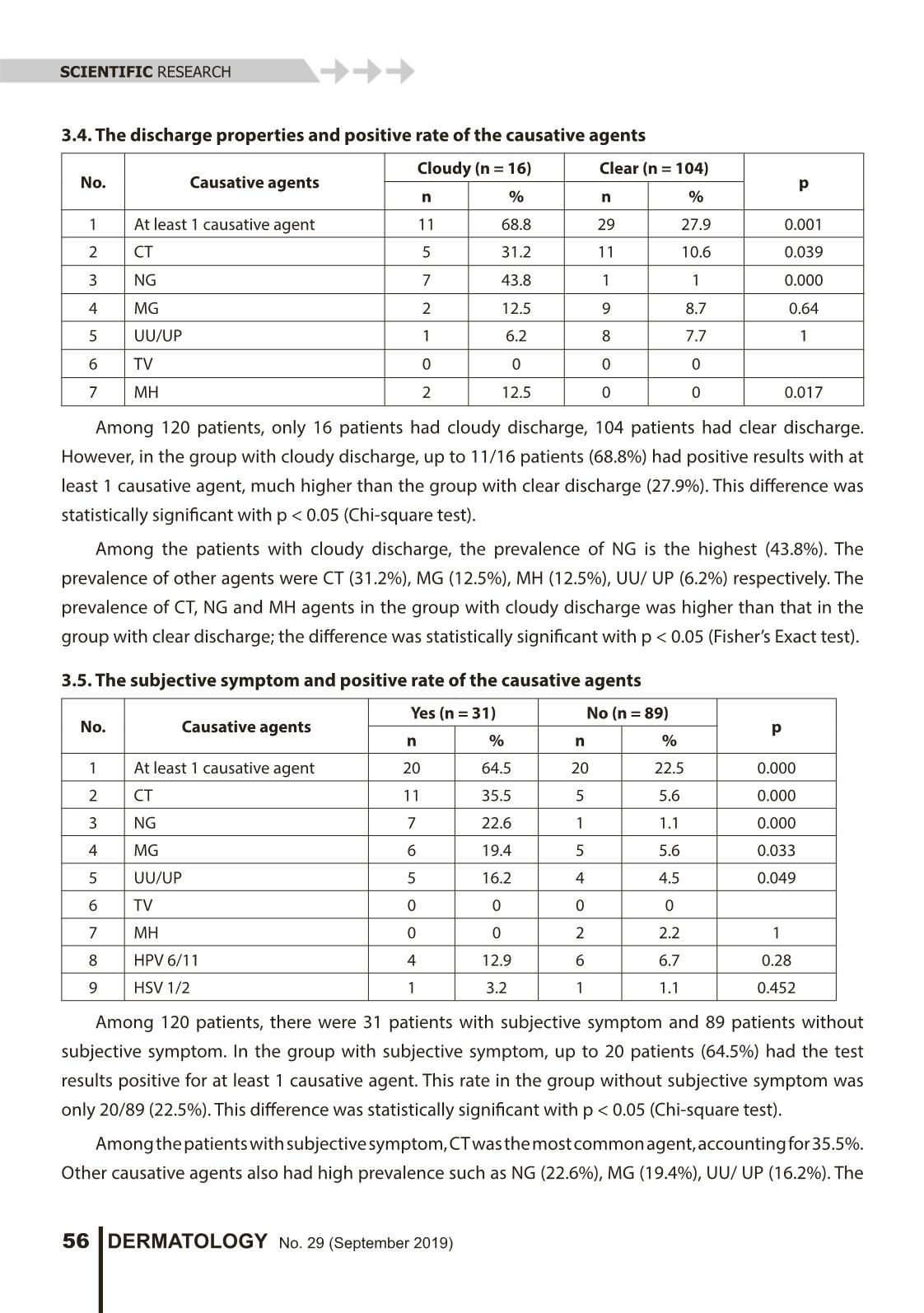
Trang 5
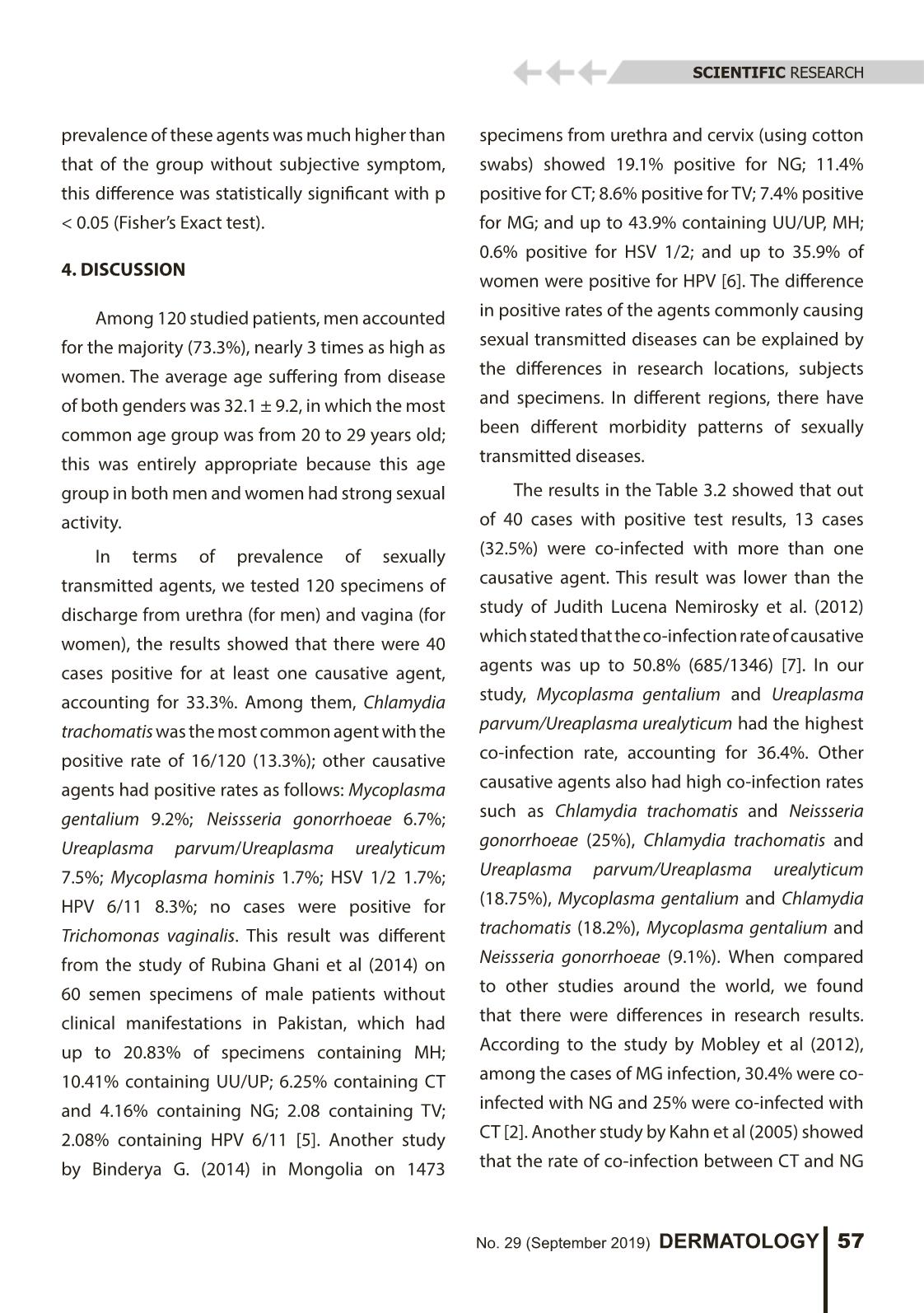
Trang 6
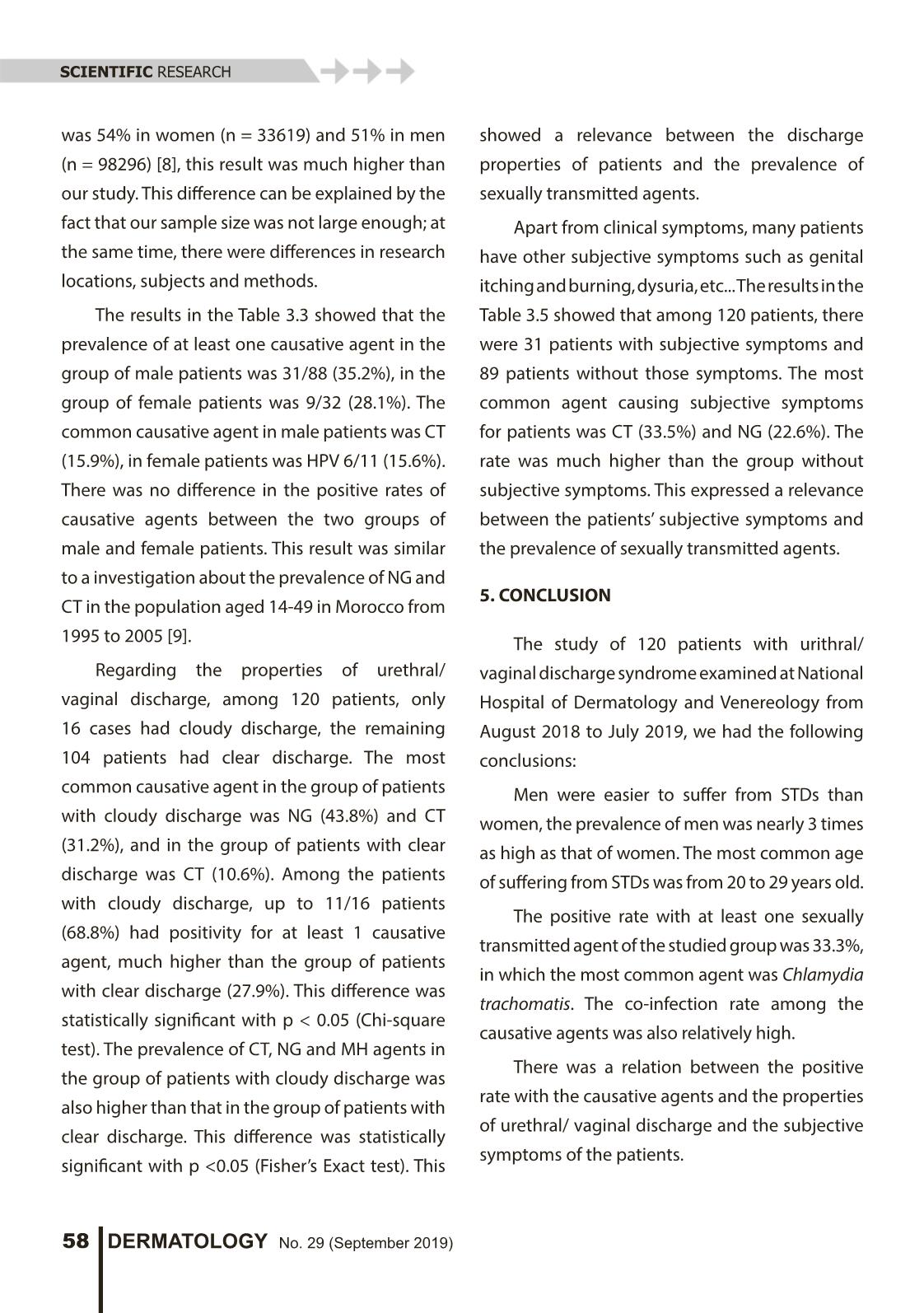
Trang 7
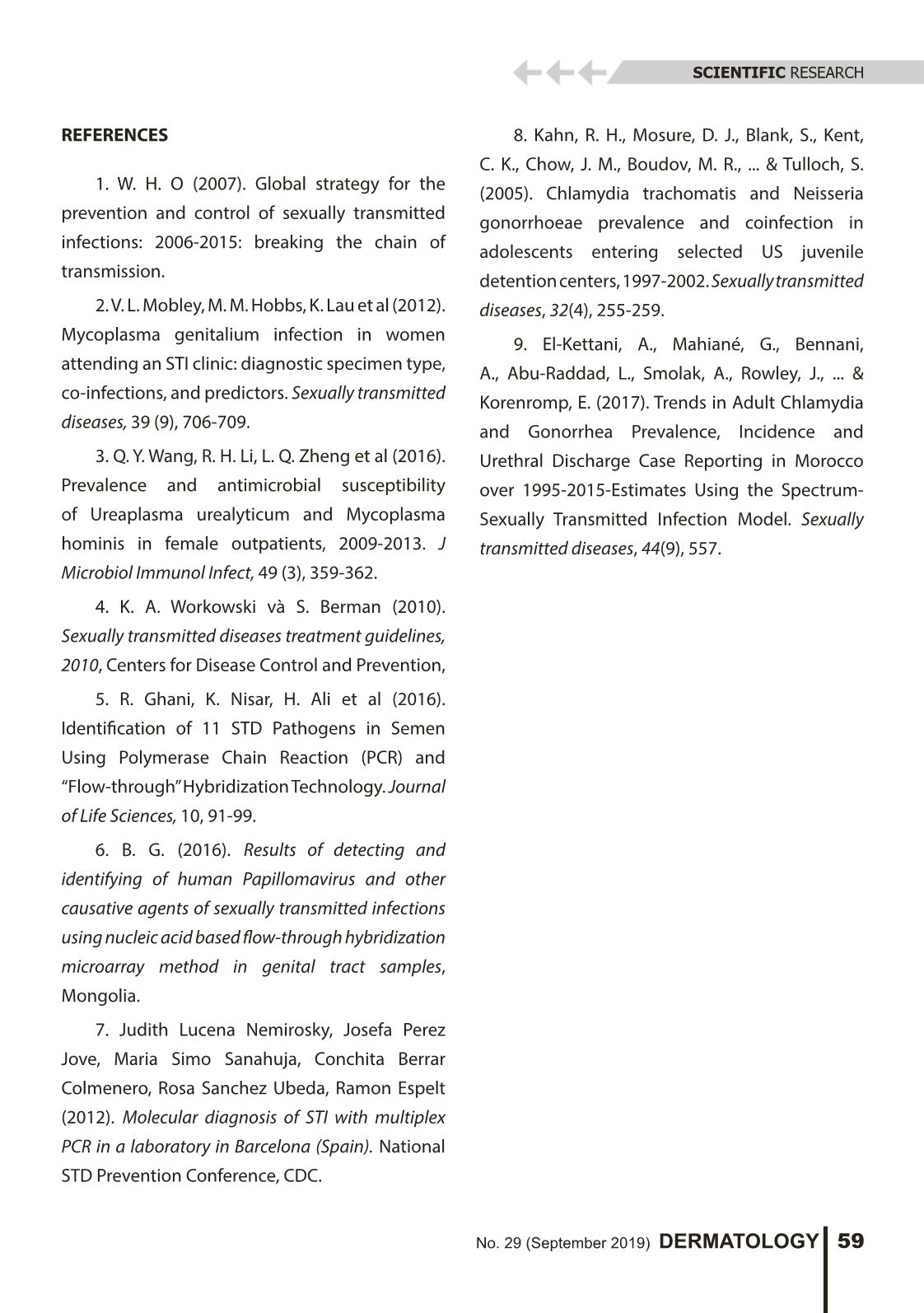
Trang 8
Tóm tắt nội dung tài liệu: The positive rate with the common sexually transmitted agents and some relevant factors of the patients with urethral/vaginal discharge syndrome
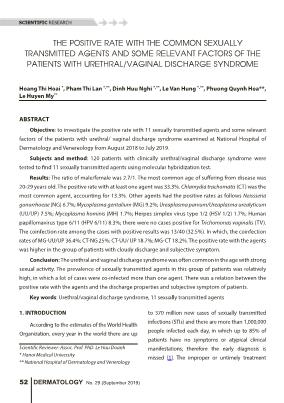
52 DERMATOLOGY No. 29 (September 2019) SCIENTIFIC RESEARCH THE POSITIVE RATE WITH THE COMMON SEXUALLY TRANSMITTED AGENTS AND SOME RELEVANT FACTORS OF THE PATIENTS WITH URETHRAL/VAGINAL DISCHARGE SYNDROME Hoang Thi Hoai *, Pham Thi Lan *,**, Dinh Huu Nghi *,**, Le Van Hung *,**, Phuong Quynh Hoa**, Le Huyen My** ABSTRACT Objective: to investigate the positive rate with 11 sexually transmitted agents and some relevant factors of the patients with urethral/ vaginal discharge syndrome examined at National Hospital of Dermatology and Venereology from August 2018 to July 2019. Subjects and method: 120 patients with clinically urethral/vaginal discharge syndrome were tested to find 11 sexually transmitted agents using molecular hybridization test. Results: The ratio of male/female was 2.7/1. The most common age of suffering from disease was 20-29 years old. The positive rate with at least one agent was 33.3%. Chlamydia trachomatis (CT) was the most common agent, accounting for 13.3%. Other agents had the positive rates as follows Neissseria gonorrhoeae (NG) 6.7%; Mycoplasma gentalium (MG) 9.2%; Ureaplasma parvum/Ureaplasma urealyticum (UU/UP) 7.5%; Mycoplasma hominis (MH) 1.7%; Herpes simplex virus type 1/2 (HSV 1/2) 1.7%; Human papillomavirus type 6/11 (HPV 6/11) 8.3%; there were no cases positive for Trichomonas vaginalis (TV). The coinfection rate among the cases with positive results was 13/40 (32.5%). In which, the coinfection rates of MG-UU/UP 36.4%; CT-NG 25%; CT-UU/ UP 18.7%; MG-CT 18.2%. The positive rate with the agents was higher in the group of patients with cloudy discharge and subjective symptom. Conclusion: The urethral and vaginal discharge syndrome was often common in the age with strong sexual activity. The prevalence of sexually transmitted agents in this group of patients was relatively high, in which a lot of cases were co-infected more than one agent. There was a relation between the positive rate with the agents and the discharge properties and subjective symptom of patients. Key words: Urethral/vaginal discharge syndrome, 11 sexually transmitted agents 1. INTRODUCTION According to the estimates of the World Health Organization, every year in the world there are up to 370 million new cases of sexually transmitted infections (STIs) and there are more than 1,000,000 people infected each day, in which up to 85% of patients have no symptoms or atypical clinical manifestations; therefore the early diagnosis is missed [1]. The improper or untimely treatment Scientific Reviewer: Assoc. Prof. PhD. Le Huu Doanh * Hanoi Medical University ** National Hospital of Dermatology and Venerology 53No. 29 (September 2019) DERMATOLOGY SCIENTIFIC RESEARCH increases the risk of complications for the patients and the risk of drug resistance. Thus, a proper diagnosis is very necessary before starting treatment. Currently, more than 30 bacteria, viruses and parasites, which can cause sexually transmitted diseases, have been identified, such as Chlamydia trachomatis, Neissseria gonorrhoeae, Treponema pallidum, Mycoplasma, Herpes simpex virus, Ureaplasma, Human papillomavirus, Trichomonas vaginalis, Among them, sexually transmitted diseases (STDs) also had a high rate of coinfection; in particular, 30.4% of patients infected with Mycoplasma genitalium were co-infected with gonorrhea and 25% were co-infected with Chlamydia trachomatis [2]; 3.4% of patients infected with Mycoplasma hominis were co- infected with Ureaplasma urealyticum [3]. Depending on the causative agents, there are many different diagnostic methods such as Gram staining, cultivation, serological reaction, nucleic acid amplification test, etc... The test to find 11 sexually transmitted agents by molecular hybridization method based on the nucleic acid amplification reaction has high sensitivity and specificity, and it is quick to have the testing results. This test has been approved for diagnosis of sexually transmitted diseases by Centers for Disease Control and Prevention (CDC) of the United States [4]. In the world, there have been the studies on this technology in determining the prevalence of STDs; however, in Vietnam there is a lack of data and studies on this method. Therefore, we conducted a study with the aim of surveying the positive rate with 11 sexually transmitted agents and some relevant factors for the patients with urethral/vaginal discharge syndrome examined at National Hospital of Dermatology and Venereology. 2. SUBJECTS AND METHOD 2.1. Research subjects The research subjects were the patients with urethral/ vaginal discharge syndrome examined at National Hospital of Dermatology and Venereology from August 2018 to July 2019. Criteria for selecting patients: The patients had urethral discharge syndrome or vaginal discharge syndrome. - Symptoms of urethral discharge syndrome: + ... n method. - Age ≥ 18. 2.2. Research method and materials 2.2.1. Research design: Descriptive cross-sectional study. 2.2.2. Steps to conduct the study - Patients were required to report their medical history, risk factors. - Using cotton swabs to get the specimens from urethra (for men) or cervix, vagina (for women). 54 DERMATOLOGY No. 29 (September 2019) SCIENTIFIC RESEARCH - Conduct testing technologies: + DNA extraction + PCR running + Conduct molecular hybridization by using GenoFlow STD Array Test Kit and Flow Through Hybridization System of DiagCor. + Read the results by using DiagCor’s image capture system. 2.2.3. Data processing: The data were entered and processed by SPSS 19.0 statistical software. Quantitative variables were expressed as means and standard deviation, qualitative variables were expressed as percentages (%). Chi-square test or Fisher’s Exact test was used to compare the ratios. 3. RESEARCH RESULTS 3.1. General characteristics of the patients Characteristics Number of patients Percentages (%) Gender Male 88 73.3 Female 32 26.7 Age ≤ 19 1 0.8 20 - 29 58 48.3 30 - 39 39 32.5 40 - 49 13 10.8 ≥ 50 9 7.5 The percentage of male was 73.3%; the percentage of female was 26.7%. The median age of the patients was 30. The youngest patient was 19 and the oldest was 59. The most common age of suffering from disease was 20-29 and 30-39, accounting for 48.3% and 32.5%, respectively. 3.2. The positive rate with 11 sexually transmitted agents No. Causative agents Number of patients (n = 120) Percentages % 1 At least 1 causative agent 40 33.3 1 CT 16 13.3 2 NG 8 6.7 3 MG 11 9.2 4 UU/UP 9 7.5 5 TV 0 0 6 MH 2 1.7 7 HPV 6/11 10 8.3 8 HSV 1/2 2 1.7 55No. 29 (September 2019) DERMATOLOGY SCIENTIFIC RESEARCH No. Causative agents Number of patients (n = 120) Percentages % The co-infection rate of the causative agents 9 Co-infection with at least 2 causative agents 13/40 32.5 11 Co-infection with MG-CT 2/11 18.2 12 Co-infection with CT-NG 4/16 25 13 Co-infection with CT-UU/UP 3/16 18.8 14 Co-infection with MG-UU/UP 4/11 36.4 Among 120 patients participating in the study, 40 patients had the positive test results with at least one causative agent, accounting for 33.3%. In particular, CT was the most common agent, accounting for 13.3%; The percentages of other factors were respectively MG (9.2%), NG (6.7%), UU/ UP (7.5%), MH (1.7%), HSV 1/2 (1.7%), HPV 6/11 (8.3%); No patients were infected with TV. In terms of the co-infection rate among agents, among 40 patients with the positive results, there were 13 patients co-infected with more than one agent (32.5%). Among 11 patients who were positive for MG, 4 cases were co-infected with UU/ UP (36.4%) and 2 cases were co-infected with CT (18.2%). In 16 cases positive for CT, 4 cases were co-infected with NG (25%) and 3 cases were co-infected with UU/ UP (18.8%). 3.3. Gender and positive rate of the causative agents No. Causative agents Urethral discharge (n = 88) Vaginal discharge (n = 32) p n % n % 1 At least 1 causative agent 31 35.2 9 28.1 0.465 2 CT 14 15.9 2 6.2 0.231 3 NG 7 8 1 3.1 0.68 4 MG 8 9.1 3 9.4 1 5 UU/UP 7 8 2 6.2 1 6 TV 0 0 0 0 7 MH 0 0 2 6.2 0.069 8 HPV 6/11 5 5.7 5 15.6 0.129 9 HSV 1/2 2 2.3 0 0 1 Among the 120 patients, 88 patients had urethral discharge syndrome (male patients) and 32 patients had vaginal discharge syndrome (female patients). The prevalence of at least 1 causative agent in the male group was 31/88 (35.2%), in the female group was 9/32 (28.1%). The common causative agent in the male group was CT (15.9%), and in the female group was HPV 6/11 (15.6%). The difference in the prevalences of agents in the two groups was not statistically significant with p > 0.05 (Fisher’s Exact test). 56 DERMATOLOGY No. 29 (September 2019) SCIENTIFIC RESEARCH 3.4. The discharge properties and positive rate of the causative agents No. Causative agents Cloudy (n = 16) Clear (n = 104) p n % n % 1 At least 1 causative agent 11 68.8 29 27.9 0.001 2 CT 5 31.2 11 10.6 0.039 3 NG 7 43.8 1 1 0.000 4 MG 2 12.5 9 8.7 0.64 5 UU/UP 1 6.2 8 7.7 1 6 TV 0 0 0 0 7 MH 2 12.5 0 0 0.017 Among 120 patients, only 16 patients had cloudy discharge, 104 patients had clear discharge. However, in the group with cloudy discharge, up to 11/16 patients (68.8%) had positive results with at least 1 causative agent, much higher than the group with clear discharge (27.9%). This difference was statistically significant with p < 0.05 (Chi-square test). Among the patients with cloudy discharge, the prevalence of NG is the highest (43.8%). The prevalence of other agents were CT (31.2%), MG (12.5%), MH (12.5%), UU/ UP (6.2%) respectively. The prevalence of CT, NG and MH agents in the group with cloudy discharge was higher than that in the group with clear discharge; the difference was statistically significant with p < 0.05 (Fisher’s Exact test). 3.5. The subjective symptom and positive rate of the causative agents No. Causative agents Yes (n = 31) No (n = 89) p n % n % 1 At least 1 causative agent 20 64.5 20 22.5 0.000 2 CT 11 35.5 5 5.6 0.000 3 NG 7 22.6 1 1.1 0.000 4 MG 6 19.4 5 5.6 0.033 5 UU/UP 5 16.2 4 4.5 0.049 6 TV 0 0 0 0 7 MH 0 0 2 2.2 1 8 HPV 6/11 4 12.9 6 6.7 0.28 9 HSV 1/2 1 3.2 1 1.1 0.452 Among 120 patients, there were 31 patients with subjective symptom and 89 patients without subjective symptom. In the group with subjective symptom, up to 20 patients (64.5%) had the test results positive for at least 1 causative agent. This rate in the group without subjective symptom was only 20/89 (22.5%). This difference was statistically significant with p < 0.05 (Chi-square test). Among the patients with subjective symptom, CT was the most common agent, accounting for 35.5%. Other causative agents also had high prevalence such as NG (22.6%), MG (19.4%), UU/ UP (16.2%). The 57No. 29 (September 2019) DERMATOLOGY SCIENTIFIC RESEARCH prevalence of these agents was much higher than that of the group without subjective symptom, this difference was statistically significant with p < 0.05 (Fisher’s Exact test). 4. DISCUSSION Among 120 studied patients, men accounted for the majority (73.3%), nearly 3 times as high as women. The average age suffering from disease of both genders was 32.1 ± 9.2, in which the most common age group was from 20 to 29 years old; this was entirely appropriate because this age group in both men and women had strong sexual activity. In terms of prevalence of sexually transmitted agents, we tested 120 specimens of discharge from urethra (for men) and vagina (for women), the results showed that there were 40 cases positive for at least one causative agent, accounting for 33.3%. Among them, Chlamydia trachomatis was the most common agent with the positive rate of 16/120 (13.3%); other causative agents had positive rates as follows: Mycoplasma gentalium 9.2%; Neissseria gonorrhoeae 6.7%; Ureaplasma parvum/Ureaplasma urealyticum 7.5%; Mycoplasma hominis 1.7%; HSV 1/2 1.7%; HPV 6/11 8.3%; no cases were positive for Trichomonas vaginalis. This result was different from the study of Rubina Ghani et al (2014) on 60 semen specimens of male patients without clinical manifestations in Pakistan, which had up to 20.83% of specimens containing MH; 10.41% containing UU/UP; 6.25% containing CT and 4.16% containing NG; 2.08 containing TV; 2.08% containing HPV 6/11 [5]. Another study by Binderya G. (2014) in Mongolia on 1473 specimens from urethra and cervix (using cotton swabs) showed 19.1% positive for NG; 11.4% positive for CT; 8.6% positive for TV; 7.4% positive for MG; and up to 43.9% containing UU/UP, MH; 0.6% positive for HSV 1/2; and up to 35.9% of women were positive for HPV [6]. The difference in positive rates of the agents commonly causing sexual transmitted diseases can be explained by the differences in research locations, subjects and specimens. In different regions, there have been different morbidity patterns of sexually transmitted diseases. The results in the Table 3.2 showed that out of 40 cases with positive test results, 13 cases (32.5%) were co-infected with more than one causative agent. This result was lower than the study of Judith Lucena Nemirosky et al. (2012) which stated that the co-infection rate of causative agents was up to 50.8% (685/1346) [7]. In our study, Mycoplasma gentalium and Ureaplasma parvum/Ureaplasma urealyticum had the highest co-infection rate, accounting for 36.4%. Other causative agents also had high co-infection rates such as Chlamydia trachomatis and Neissseria gonorrhoeae (25%), Chlamydia trachomatis and Ureaplasma parvum/Ureaplasma urealyticum (18.75%), Mycoplasma gentalium and Chlamydia trachomatis (18.2%), Mycoplasma gentalium and Neissseria gonorrhoeae (9.1%). When compared to other studies around the world, we found that there were differences in research results. According to the study by Mobley et al (2012), among the cases of MG infection, 30.4% were co- infected with NG and 25% were co-infected with CT [2]. Another study by Kahn et al (2005) showed that the rate of co-infection between CT and NG 58 DERMATOLOGY No. 29 (September 2019) SCIENTIFIC RESEARCH was 54% in women (n = 33619) and 51% in men (n = 98296) [8], this result was much higher than our study. This difference can be explained by the fact that our sample size was not large enough; at the same time, there were differences in research locations, subjects and methods. The results in the Table 3.3 showed that the prevalence of at least one causative agent in the group of male patients was 31/88 (35.2%), in the group of female patients was 9/32 (28.1%). The common causative agent in male patients was CT (15.9%), in female patients was HPV 6/11 (15.6%). There was no difference in the positive rates of causative agents between the two groups of male and female patients. This result was similar to a investigation about the prevalence of NG and CT in the population aged 14-49 in Morocco from 1995 to 2005 [9]. Regarding the properties of urethral/ vaginal discharge, among 120 patients, only 16 cases had cloudy discharge, the remaining 104 patients had clear discharge. The most common causative agent in the group of patients with cloudy discharge was NG (43.8%) and CT (31.2%), and in the group of patients with clear discharge was CT (10.6%). Among the patients with cloudy discharge, up to 11/16 patients (68.8%) had positivity for at least 1 causative agent, much higher than the group of patients with clear discharge (27.9%). This difference was statistically significant with p < 0.05 (Chi-square test). The prevalence of CT, NG and MH agents in the group of patients with cloudy discharge was also higher than that in the group of patients with clear discharge. This difference was statistically significant with p <0.05 (Fisher’s Exact test). This showed a relevance between the discharge properties of patients and the prevalence of sexually transmitted agents. Apart from clinical symptoms, many patients have other subjective symptoms such as genital itching and burning, dysuria, etc... The results in the Table 3.5 showed that among 120 patients, there were 31 patients with subjective symptoms and 89 patients without those symptoms. The most common agent causing subjective symptoms for patients was CT (33.5%) and NG (22.6%). The rate was much higher than the group without subjective symptoms. This expressed a relevance between the patients’ subjective symptoms and the prevalence of sexually transmitted agents. 5. CONCLUSION The study of 120 patients with urithral/ vaginal discharge syndrome examined at National Hospital of Dermatology and Venereology from August 2018 to July 2019, we had the following conclusions: Men were easier to suffer from STDs than women, the prevalence of men was nearly 3 times as high as that of women. The most common age of suffering from STDs was from 20 to 29 years old. The positive rate with at least one sexually transmitted agent of the studied group was 33.3%, in which the most common agent was Chlamydia trachomatis. The co-infection rate among the causative agents was also relatively high. There was a relation between the positive rate with the causative agents and the properties of urethral/ vaginal discharge and the subjective symptoms of the patients. 59No. 29 (September 2019) DERMATOLOGY SCIENTIFIC RESEARCH REFERENCES 1. W. H. O (2007). Global strategy for the prevention and control of sexually transmitted infections: 2006-2015: breaking the chain of transmission. 2. V. L. Mobley, M. M. Hobbs, K. Lau et al (2012). Mycoplasma genitalium infection in women attending an STI clinic: diagnostic specimen type, co-infections, and predictors. Sexually transmitted diseases, 39 (9), 706-709. 3. Q. Y. Wang, R. H. Li, L. Q. Zheng et al (2016). Prevalence and antimicrobial susceptibility of Ureaplasma urealyticum and Mycoplasma hominis in female outpatients, 2009-2013. J Microbiol Immunol Infect, 49 (3), 359-362. 4. K. A. Workowski và S. Berman (2010). Sexually transmitted diseases treatment guidelines, 2010, Centers for Disease Control and Prevention, 5. R. Ghani, K. Nisar, H. Ali et al (2016). Identification of 11 STD Pathogens in Semen Using Polymerase Chain Reaction (PCR) and “Flow-through” Hybridization Technology. Journal of Life Sciences, 10, 91-99. 6. B. G. (2016). Results of detecting and identifying of human Papillomavirus and other causative agents of sexually transmitted infections using nucleic acid based flow-through hybridization microarray method in genital tract samples, Mongolia. 7. Judith Lucena Nemirosky, Josefa Perez Jove, Maria Simo Sanahuja, Conchita Berrar Colmenero, Rosa Sanchez Ubeda, Ramon Espelt (2012). Molecular diagnosis of STI with multiplex PCR in a laboratory in Barcelona (Spain). National STD Prevention Conference, CDC. 8. Kahn, R. H., Mosure, D. J., Blank, S., Kent, C. K., Chow, J. M., Boudov, M. R., ... & Tulloch, S. (2005). Chlamydia trachomatis and Neisseria gonorrhoeae prevalence and coinfection in adolescents entering selected US juvenile detention centers, 1997-2002. Sexually transmitted diseases, 32(4), 255-259. 9. El-Kettani, A., Mahiané, G., Bennani, A., Abu-Raddad, L., Smolak, A., Rowley, J., ... & Korenromp, E. (2017). Trends in Adult Chlamydia and Gonorrhea Prevalence, Incidence and Urethral Discharge Case Reporting in Morocco over 1995-2015-Estimates Using the Spectrum- Sexually Transmitted Infection Model. Sexually transmitted diseases, 44(9), 557.
File đính kèm:
 the_positive_rate_with_the_common_sexually_transmitted_agent.pdf
the_positive_rate_with_the_common_sexually_transmitted_agent.pdf

